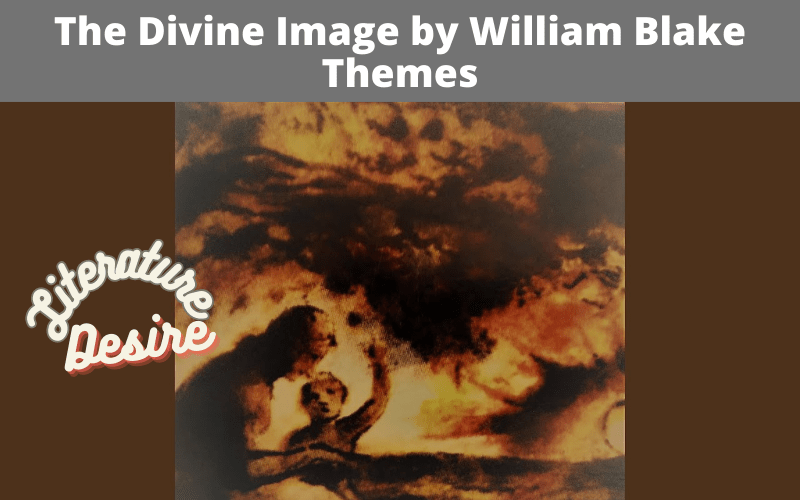Discover the major themes in “The Divine Image” by William Blake in this insightful article. Explore the profound ideas conveyed by Blake through his thought-provoking poetry. Chimney Sweeper and Infant Sorrow are thought-provoking poems by William Blake.
William Blake, a renowned poet, and artist of the Romantic era, delved into the depths of human experience and spirituality through his profound works. One of his notable poems, “The Divine Image,” encapsulates his vision of the divine and explores key themes that resonate with readers even today.
Advertisement
Major Themes in “The Divine Image” by William Blake
The Divine Image by William Blake encompasses various profound themes, each contributing to the overall richness and depth of the poem. Let’s delve into these themes and unravel their significance in Blake’s work.
Advertisement
Love as a Divine Attribute
Love is portrayed as a fundamental divine attribute in “The Divine Image.” Blake emphasizes the importance of love as an essential aspect of human nature, reflecting the divine qualities within individuals.
Advertisement
Love acts as a unifying force, fostering connections between people and transcending boundaries of race, religion, and nationality.
Advertisement
Mercy: A Powerful Expression of the Divine
Mercy, another prominent theme in Blake’s poem, highlights the compassionate and forgiving nature of the divine. Through mercy, individuals can reflect the divine image within themselves.
Pity: The Essence of Humanity
Blake considers pity as an essential human emotion that leads to empathy and compassion. Pity allows individuals to understand and connect with the suffering of others, fostering a sense of solidarity and unity.
In “The Divine Image,” Blake urges readers to embrace pity as a means to uplift and support one another.
Equality: The Ideal Society: Themes in The Divine Image
Equality emerges as a key theme in “The Divine Image,” advocating for a society free from discrimination and oppression. Blake emphasizes that all individuals possess the divine image within them, regardless of their social status or background. The poem encourages the recognition of inherent worth and the importance of equal treatment for all.
Forgiveness: Transcending Human Limitations
Blake explores the transformative power of forgiveness in “The Divine Image.” By forgiving others and oneself, individuals can rise above their limitations and foster personal growth. Forgiveness enables the mending of broken relationships and the healing of emotional wounds, allowing individuals to embrace their divine nature fully.
The Human Experience: Suffering and Joy in “The Divine Image”
“The Divine Image” by William Blake delves into the complexities of the human experience, encompassing both moments of suffering and joy.
Blake acknowledges the presence of pain, sorrow, and hardship, recognizing that these experiences can shape individuals and test their resilience.
The acknowledgment of suffering serves to highlight the significance of compassion and empathy, as individuals can draw upon their own experiences of suffering to connect with and support others.
Click here to read the Critical Analysis of The Divine Image
However, Blake also emphasizes the importance of joy in “The Divine Image.” He celebrates moments of happiness, contentment, and delight, recognizing them as glimpses of the divine within the human experience. Joy becomes a source of inspiration and motivation, reminding individuals of the beauty and potential for goodness in the world.
By exploring both suffering and joy, Blake presents a balanced perspective on the human experience. He acknowledges the challenges individuals face and the inherent struggles of life, while also offering hope and encouragement through moments of joy.
Through this juxtaposition, Blake encourages readers to embrace the entirety of their experiences and find meaning in the diverse range of emotions encountered along the journey of life.
In essence, “The Divine Image” captures the profound truth that suffering and joy are intertwined aspects of the human experience.
Through his poetry, Blake encourages individuals to find strength and compassion in the face of suffering while embracing and celebrating moments of joy.
It is through this balance that individuals can fully embody the divine image within them and navigate the complexities of the human condition.
Compassion: Connecting with the Divine
“Compassion,” a central theme in “The Divine Image” by William Blake, highlights the transformative power of empathy and understanding. Blake emphasizes that true connection with the divine can be achieved through acts of compassion towards others.
In the poem, compassion is portrayed as a fundamental quality that reflects the divine image within individuals. Blake emphasizes that compassion allows individuals to see beyond external differences and recognize the shared humanity in every person.

The Importance of Virtue: Themes in The Divine Image
In “The Divine Image” by William Blake, the importance of virtue is a prominent theme that underscores the poem’s exploration of human nature and the divine. Blake emphasizes that embodying virtuous qualities is crucial for individuals to reflect the divine image within themselves and foster a harmonious society.
By embracing virtue, individuals transcend selfish desires and act in accordance with higher principles. In “The Divine Image” by William Blake, the importance of virtue is a prominent theme that underscores the poem’s exploration of human nature and the divine.
Blake emphasizes that embodying virtuous qualities is crucial for individuals to reflect the divine image within themselves and foster a harmonious society.
The Rejection of Negativity and Hate
Within “The Divine Image” by William Blake, the rejection of negativity and hate emerges as a powerful theme, reflecting the poet’s vision of a world guided by love and compassion.
Blake emphasizes the importance of shunning negative emotions and embracing positive qualities to embody the divine image. Negativity and hate are depicted as forces that hinder the manifestation of the divine within individuals.
Blake suggests that dwelling in negativity not only harms oneself but also perpetuates a cycle of pain and discord in society. By rejecting these destructive emotions, individuals can create space for love, compassion, and understanding to flourish.
Blake urges individuals to let go of grudges, prejudice, and animosity, recognizing that these emotions distance them from the divine essence. By actively choosing love and compassion, individuals can break free from the constraints of negativity and hate, embracing a path that leads to personal growth and spiritual enlightenment.
The Divine Image Within Every Individual
“The Divine Image” by William Blake conveys the profound belief that every individual possesses the divine image within themselves. This theme emphasizes the inherent worth and sacredness of every human being, highlighting the potential for goodness and spiritual connection within each individual.
Blake suggests that the divine image is not limited to a select few but is universally present within every person. This notion challenges societal hierarchies and promotes the idea of equal dignity for all. It encourages individuals to recognize and honor the divine essence within themselves and others, fostering a sense of unity and interconnectedness.
By acknowledging the divine image within every individual, “The Divine Image” encourages readers to embrace empathy, compassion, and respect toward others.
Questions of Morality and Ethics: Themes in The Divine Image
In “The Divine Image” by William Blake, questions of morality and ethics play a significant role, challenging readers to contemplate the principles that guide human conduct and the embodiment of the divine image.
The poem invites reflection on the moral choices individuals make and their impact on personal character and society. “The Divine Image” also confronts the conventional notions of morality upheld by society and organized religion.
The Imperfection of Humanity
In “The Divine Image” by William Blake, the imperfection of humanity is a theme that shines a light on the flawed nature of individuals despite the divine image within them.
Blake presents a realistic portrayal of human imperfections, acknowledging the existence of vices and shortcomings that often overshadow divine qualities. Moreover, the recognition of human imperfections in “The Divine Image” fosters humility and empathy.
In essence, “The Divine Image” acknowledges the imperfection of humanity despite the divine essence within individuals.
Conclusion: Themes in The Divine Image
“The Divine Image” by William Blake encompasses a range of major themes that resonate with readers across time. Blake’s exploration of love, mercy, equality, forgiveness, and other profound concepts encourages individuals to embrace their divine nature and foster a harmonious and compassionate society.
Frequently Asked Questions
The central message of “The Divine Image” revolves around the inherent divine qualities within every individual, such as love, mercy, and compassion. Blake encourages readers to embrace these qualities and foster a harmonious and equal society.
Forgiveness is portrayed as a transformative force in “The Divine Image.” Blake suggests that forgiveness enables individuals to transcend their limitations and cultivate personal growth. It also fosters healing, reconciliation, and the restoration of relationships.
Blake challenges traditional religious practices in “The Divine Image” by asserting that the essence of divinity lies in love, mercy, and compassion rather than rigid rituals and doctrines. He emphasizes the need to focus on inner virtues and the embodiment of divine attributes.
Innocence is depicted as a state of purity and divine reflection in “The Divine Image.” Blake suggests that embracing innocence allows individuals to connect with their innate divine qualities, fostering harmony and spiritual growth.
“The Divine Image” connects with readers today by addressing universal themes such as love, mercy, equality, and forgiveness. The poem’s profound insights into the human experience and spirituality remain relevant, offering guidance and inspiration in navigating contemporary challenges.

